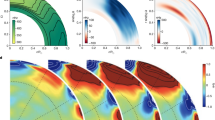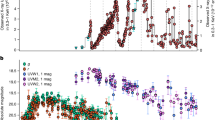Abstract
The number of indirectly detected planetary systems around nearby stars has grown tremendously since their initial discovery five years ago1. But the direct observation of light reflected from these systems remains a formidable task, because of the high contrast ratios between them and their parent stars, and because of the tiny angular separations. Theoretically2, these difficulties can be overcome by using a dual-aperture stellar interferometer in which the starlight is cancelled, or ‘nulled’, by broadband destructive interference, leaving the planet's light visible. Although the basic requirement of equal and oppositely directed electric fields is easy to state, an experimental demonstration of deep broadband nulling has been lacking, owing to difficulties engendered by the needs for extreme symmetry and stability, and low dispersion in the optical system. Here we report the deep (10-4) and stable nulling of broadband (18% bandwidth) thermal light. These results validate the physical principles underlying future planet-searching interferometers, and our laboratory instrument will serve as a prototype for the nulling instrument to be implemented on the Keck interferometer in 2001.
This is a preview of subscription content, access via your institution
Access options
Subscribe to this journal
Receive 51 print issues and online access
$199.00 per year
only $3.90 per issue
Buy this article
- Purchase on Springer Link
- Instant access to full article PDF
Prices may be subject to local taxes which are calculated during checkout


Similar content being viewed by others
References
Mayor, M. & Queloz, D. A Jupiter-mass companion to a solar-type star. Nature 378, 355–359 (1995).
Bracewell, R. N. Detecting nonsolar planets by spinning infrared interferometer. Nature 274, 780–781 ( 1978).
Bracewell, R. N. & Macphie, R. H. Searching for nonsolar planets. Icarus 38, 136– 147 (1979).
Diner, D. J. in The Next Generation Space Telescope (eds Bely, P. Y., Burrows, C. J. & Illingworth, G. D.) 133–141 (Space Telescope Science Institute, Baltimore, 1990).
Shao, M. in The Next Generation Space Telescope (eds Bely, P. Y., Burrows, C. J. & Illingworth, G. D.) 160–168 (Space Telescope Science Institute, Baltimore, 1990).
Diner, D. J., Tubbs, E. F., Gaiser, S. L. & Korechoff, R. P. Infrared imaging of extrasolar planets. J. Br. Interplanet. Soc. 44, 505–512 ( 1991).
Shao, M. in Space Astronomical Telescopes and Instrumentation (eds Bely, P. Y. & Breckinridge, J. B.) Proc. SPIE 1494, 347– 356 (1991).
Gay, J. & Rabbia, Y. Principe d'un coronographe interférentiel. C.R. Acad. Sci. Paris 322, 265– 271 (1996).
Angel, J. R. P. in The Next Generation Space Telescope (eds Bely, P. Y., Burrows, C. J. & Illingworth, G. D.) 81–94 (Space Telescope Science Institute, Baltimore, 1990).
Angel, J. R. P., Burge, J. H. & Woolf, N. J. Detection and spectroscopy of exo-planets like Earth. Proc. SPIE 2871, 516–519 (1996).
Badouz, P. et al. First results with the achromatic interfero coronagraph. Proc. SPIE 3353, 455–462 (1998).
Hinz, P. M. et al. Imaging circumstellar environments with a nulling interferometer. Nature 395, 251–253 (1998).
Danner, R. & Unwin, S. (eds) Space Interferometry Mission (SIM) 103–124 (JPL Brochure 400–811, Jet Propulsion Laboratory, Pasadena, 1999).
Serabyn, E., Wallace, J. K., Hardy, G. J., Schmidtlin, E. G. H. & Nguyen, H. Deep nulling of visible laser light. Appl. Opt. 38, 7128 –7132 (1999).
Serabyn, E., Wallace, J. K., Nguyen, H. T., Schmiditlin, E. G. H. & Hardy, G. J. in Working on the Fringe: Optical and IR Interferometry from Ground and Space (eds Unwin, S. & Stachnik, R.) 437–442 (ASP Conf. Ser. 194, Astronomical Society of the Pacific, San Francisco, 1990).
Ollivier, M. & Mariotti, J.-M. Improvement in the rejection rate of a nulling interferometer by spatial filtering. Appl. Opt. 36, 5340–5346 ( 1997).
Serabyn, E. Nanometer-level path-length control scheme for nulling interferometry. Appl. Opt. 38, 4213–4216 (1999).
Beichman, . A., Woolf, N. J. & Lindensmith, C. A. (eds) Terrestrial Planet Finder (TPF) (JPL Publication 99-3, Jet Propulsion Laboratory, Pasadena, 1999 ).
Colavita, M. M. et al. The Keck Interferometer. Proc. SPIE 3350, 776–784 (1998).
Leger, A. et al. Could we search for primitive life on extrasolar planets in the near future? The DARWIN project. Icarus 123, 249–255 (1996).
Acknowledgements
We thank the Keck Interferometer and SIM projects for their support of this work. We also thank H. Nguyen for help with data acquisition. The work reported here was performed at the Jet Propulsion Laboratory, California Institute of Technology, under a contract with the National Aeronautics and Space Administration.
Author information
Authors and Affiliations
Corresponding author
Rights and permissions
About this article
Cite this article
Wallace, K., Hardy, G. & Serabyn, E. Deep and stable interferometric nulling of broadband light with implications for observing planets around nearby stars. Nature 406, 700–702 (2000). https://doi.org/10.1038/35021007
Received:
Accepted:
Published:
Issue Date:
DOI: https://doi.org/10.1038/35021007
Comments
By submitting a comment you agree to abide by our Terms and Community Guidelines. If you find something abusive or that does not comply with our terms or guidelines please flag it as inappropriate.



